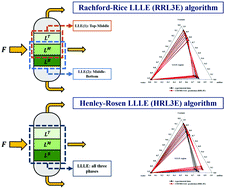A priori prediction of complex liquid–liquid–liquid equilibria in organic systems using a continuum solvation model†
Abstract
Liquid–liquid–liquid equilibria (LLLE) is usually observed in many industrial processes primarily linked to enhanced oil recovery techniques. However their measurements are complex and so are their computations. An inherently predictive tool is often useful for elucidating their distribution ratios and phase compositions. In the present work, the phase behavior of nine ternary and two quaternary LLLE systems were predicted employing the quantum chemical based COnductor like Screening MOdel-Segment Activity Coefficient (COSMO-SAC) model. The methodology namely, Rachford–Rice LLLE (RRL3E) algorithm and Henley–Rosen LLLE (HRL3E) algorithm were used to predict the triphasic compositions in each system. In the RRL3E approach, the triphasic systems were assumed into two co-existing biphasic liquid–liquid equilibria systems, whereas in the HRL3E approach, all three phases were considered to be in equilibrium with each other simultaneously. Apart from predicting the local compositions, the HRL3E algorithm was also used to predict the individual phase splits and phase fractions of the LLLE region. Average overall root mean square deviation (rmsd (%)) values considering all 42 datasets and corresponding to 414 data points were recorded as 4.65% and 4.83% using the RRL3E and HRL3E algorithms respectively. Further, the RRL3E algorithm was extended to correlate the LLLE data for all systems using the Genetic Algorithm (GA) based NRTL (GA-NRTL) and UNIQUAC (GA-UNIQUAC) models.



 Please wait while we load your content...
Please wait while we load your content...